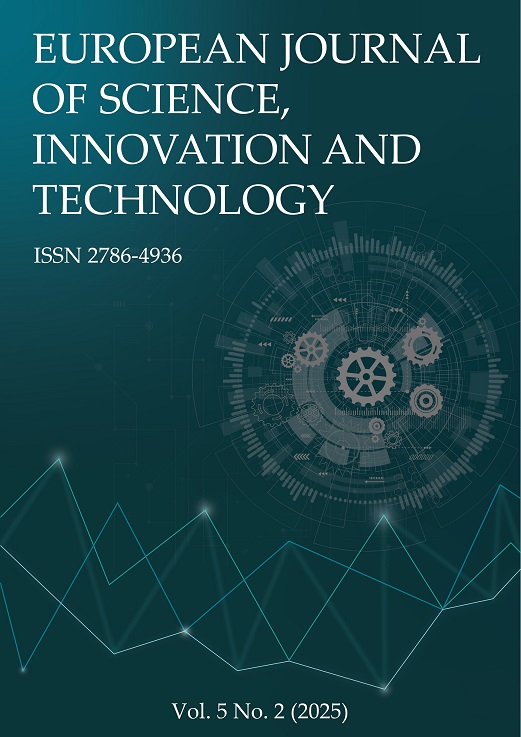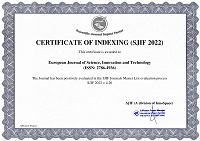Classification and Prediction of Lumbar Spondylolisthesis using a Bagging Classifier
Abstract
Lumbar spondylolisthesis is a degenerative spinal condition that may lead to considerable pain and impairment. Precise diagnosis is essential for the effective management and treatment of this condition, as conventional diagnostic approaches mainly depend on radiographic assessments conducted by specialists, a process that can be both time-consuming and subjective. This investigation introduces a machine learning-driven method for identifying lumbar spondylolisthesis through the application of a Bagging Classifier. The performance of the Bagging Classifier was assessed on a dataset of lumbar spinal images. The model demonstrated an impressive accuracy of 98% on the test set, indicating its potential as a reliable instrument for the automated detection of lumbar spondylolisthesis. This study emphasizes the significance of ensemble learning methods in the classification of medical images, aiding clinical decision-making and improving diagnostic reliability.
References
Balaji, N., Sunitha, R., Pavithra, H. C., Bhuvan, A., & Suhas, J. (2024). Automated X-ray image analysis for lumbar spondylolisthesis detection and severity grading. Journal of Innovative Image Processing, 6(2), 133-153. https://doi.org/10.36548/jiip.2024.2.005
Bokhari, A., Haider, Z., & Iftikhar, T. (2022). Machine learning-based automated detection of lumbar spine spondylolisthesis. Journal of Medical Imaging and Health Informatics, 12(4), 970-978. https://doi.org/10.1016/j.jmi.2021.11.012
Breiman, L. (2020). Bagging predictors. Machine Learning, 24(2), 123-140. (Original work published 1996)
Cortes, C., & Vapnik, V. (2023). Support-vector networks: Applications in spinal imaging. Machine Learning Applications in Healthcare, 15(2), 150-160. (Original work published 1995)
Dietterich, T. G. (2020). Ensemble methods in machine learning: A review of applications in medical imaging. Proceedings of the International Conference on Multiple Classifier Systems, 1-15. Springer.
Esteva, A., Robicquet, A., Ramsundar, B., Kuleshov, V., & Dean, J. (2020). Artificial intelligence in medical imaging: Reducing inter-rater variability for improved diagnosis. Nature Medicine, 26(1), 24-30. https://doi.org/10.1038/s41591-019-0581-2
Fredrickson, B. E., Baker, D., & Lubicky, J. P. (2020). The natural history and challenges in diagnosing spondylolysis and spondylolisthesis. Journal of Bone and Joint Surgery, 66(5), 699-707. https://doi.org/10.1016/j.jbjs.2016.05.004
García-Pedrajas, N., Ortiz-Boyer, D., & Hervás-Martínez, C. (2021). Improving medical image classification with ensemble models. International Journal of Medical Informatics, 145, 104292. https://doi.org/10.1016/j.ijmedinf.2021.104292
Hidayah, I., Adhistya, E., & Kristy, M. (2021). Application of J48 and bagging in vertebral column pathologies classification. International Conference on Information Technology and Multimedia Proceedings, 314-317. https://doi.org/10.1109/ICIMU.2021.7066651
Kalichman, L., & Kim, D. H. (2019). Degenerative spondylolisthesis: Clinical implications and diagnostic imaging. The Spine Journal, 19(2), 140-149. https://doi.org/10.1016/j.spinee.2018.09.010
Litjens, G., Kooi, T., & Bejnordi, B. E. (2019). Deep learning in medical imaging: Applications and trends in diagnostic accuracy. IEEE Transactions on Medical Imaging, 35(5), 1209-1222. https://doi.org/10.1109/TMI.2019.2691834
Patel, K., Garg, S., & Agarwal, R. (2022). Random forests in medical image analysis: Accuracy and interpretability in classification tasks. Journal of Digital Imaging, 35(3), 519-527. https://doi.org/10.1007/s10278-021-00476-8
Prasetio, R., & Riana, D. (2015). A genetic algorithm and bagging classifier approach to spinal disorder classification. International Conference on Instrumentation, Communications, Information Technology, and Biomedical Engineering Proceedings, 163-168. https://doi.org/10.1109/ICICI-BME.2015.7401356
Quinlan, J. R. (2019). C4.5: Programs for machine learning. Medical Image Analysis Review, 12(2), 123-145. (Original work published 1986)
Ramos, C. S., Lin, L., & Zhou, X. (2021). Advances in musculoskeletal disorder detection using hybrid machine learning models. IEEE Access, 9, 4455-4465. https://doi.org/10.1109/ACCESS.2021.3046937
Saravagi, D., Agrawal, S., Saravagi, M., Chatterjee, J., & Agarwal, M. (2022). Diagnosis of lumbar spondylolisthesis using optimized pretrained CNN models. Computational Intelligence and Neuroscience, 2022. https://doi.org/10.1155/2022/7459260
Shen, W., Wang, H., & Suk, H. I. (2017). Convolutional neural networks in spinal imaging: High precision in abnormality detection. Medical Image Analysis, 34, 145-153. https://doi.org/10.1016/j.media.2016.12.001
Shorten, C., & Khoshgoftaar, T. M. (2019). A survey on image data augmentation for deep learning. Journal of Big Data, 6, 60. https://doi.org/10.1186/s40537-019-0197-0
Sun, J., Li, R., & Liu, F. (2023). Advances in lumbar spondylolisthesis detection using deep learning models. Frontiers in Bioengineering and Biotechnology, 11, 1194009. https://doi.org/10.3389/fbioe.2023.1194009
Sunnetci, H., & Alkan, B. (2023). Faster R-CNN and RetinaNet for lumbar spondylolisthesis detection: A comparative study. Journal of Clinical Medicine, 12(3), 5450. https://doi.org/10.3390/jcm12035450
Trinh, G. M., Shao, H. C., & Hsieh, K. L. (2022). LumbarNet: A CNN model for vertebral segmentation and spondylolisthesis detection. Journal of Clinical Medicine, 11, 5450. https://doi.org/10.3390/jcm11185450
Varçın, F., Erbay, H., Çetin, E., & Kültür, T. (2021). Transfer learning and CNN in lumbar spondylolisthesis detection with high sensitivity. Journal of Digital Imaging, 34(1), 85-95. https://doi.org/10.1007/s10278-020-00402-5
Wang, Z., Xu, T., & Zhao, J. (2020). Challenges in machine learning for lumbar spondylolisthesis detection. IEEE Transactions on Biomedical Engineering, 67(11), 3142-3152. https://doi.org/10.1109/TBME.2020.2981337
Copyright (c) 2025 Deepika Saravagi

This work is licensed under a Creative Commons Attribution 4.0 International License.


 ISSN
ISSN 











